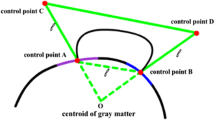Abstract
Direct volume rendering is a visualization method that allows display of all information hidden in three-dimensional data sets of, for example, computed tomography or magnetic resonance imaging (MRI). In contrast to commonly used surface rendering methods, these algorithms need no preprocessing but suffer from a high computational complexity. A real-time rendering system, VIRIM (Vitec: Visualization Technology GmbH, Mannheim, Germany), cuts down rendering times of minutes on normal workstations to an interactive rate of 1 second or less. The immediate visual feedback allows interactive steering of the visualization process to achieve insight into the internal three-dimensional structure of objects. Additional information is obtained by using an interactive gray-value segmentation tool that both allows segmentation of the data set according to bone, tissue, and liquor and display of multifunctional data sets (e.g., functional MRI [fMRI] data sets). Thus, real-time direct volume rendering allows segmentation and volume data processing of functional and anatomical MR data sets simultaneously. As this method can be integrated in the clinical routine, it is of great importance for real-time motion artifact detection and the interpretation of fMRI data acquired during cognitive experiments with normal subjects and psychiatric patients. Because of the free programmability of VIRIM, more complex matching procedures are currently being investigated for future implementation.
Similar content being viewed by others
References
Lorensen WE, Cline HE (1987) Marching cubes: a high resolution 3D surface construction algorithm.Comput Graphics 21: 163–169.
Cabral B, Cam N, Foran J (1994) Accelerated volume rendering and tomographic reconstruction using texture mapping hardware.Symposium on Vol. Vis., pp. 91–98. New York: ACP Press.
Günther T, Poliwoda C, Reinhart C, Hesser J, Männer R, Meinzer H-P, Baur HJ (1994) VIRIM: a massively parallel processor for real-time volume visualization in medicine. In9th Eurographics Workshop on Graphics Hardware, Oslo, Norway, pp. 103–108.
Meinzer H-P, Meetz K, Scheppelmann D, Engelmann U, Baur HJ (1991) The Heidelberg ray tracing model.IEEE Comp Graphics Appl 11: 34–39.
Gröpl A, Günther T, Hesser J, Kröll J, Männer R, Poliwoda C, Reinhart C, Haßfeld S, Jäger W, Quien N, Simon J, Wirth J (1996) Interactive operation planning and control with VIRIM.Proceedings: Medicine Meets Virtual Reality IV, San Diego, CA, pp. 121–133.
Author information
Authors and Affiliations
Rights and permissions
About this article
Cite this article
Hesser, J., Männer, R., Braus, D.F. et al. Real-time direct volume rendering in functional magnetic resonance imaging. MAGMA 5, 87–91 (1997). https://doi.org/10.1007/BF02592237
Received:
Accepted:
Issue Date:
DOI: https://doi.org/10.1007/BF02592237




